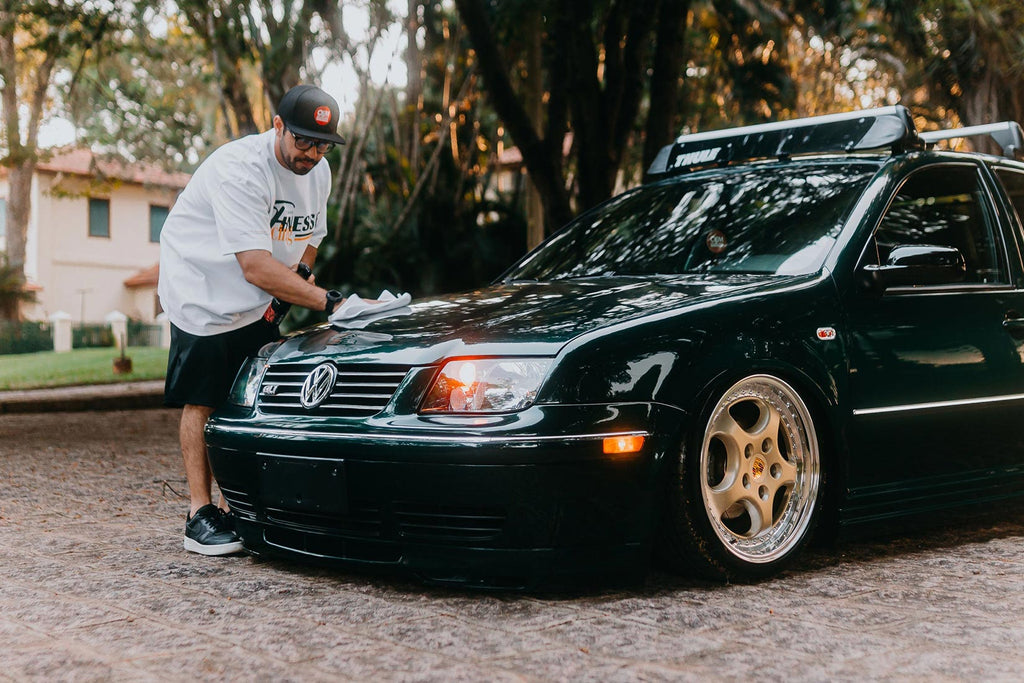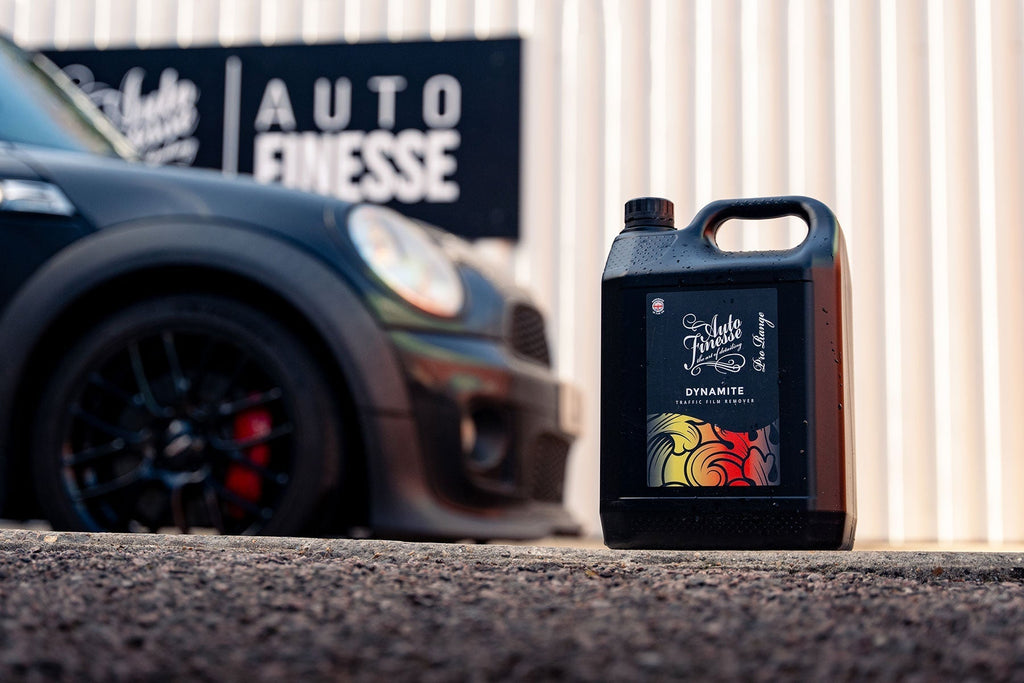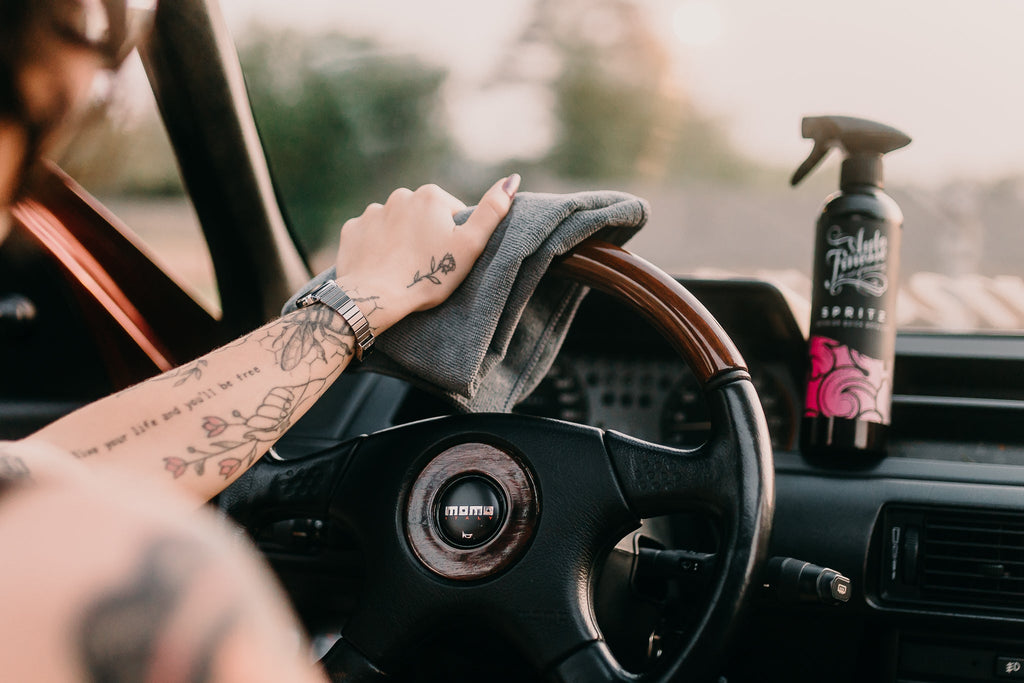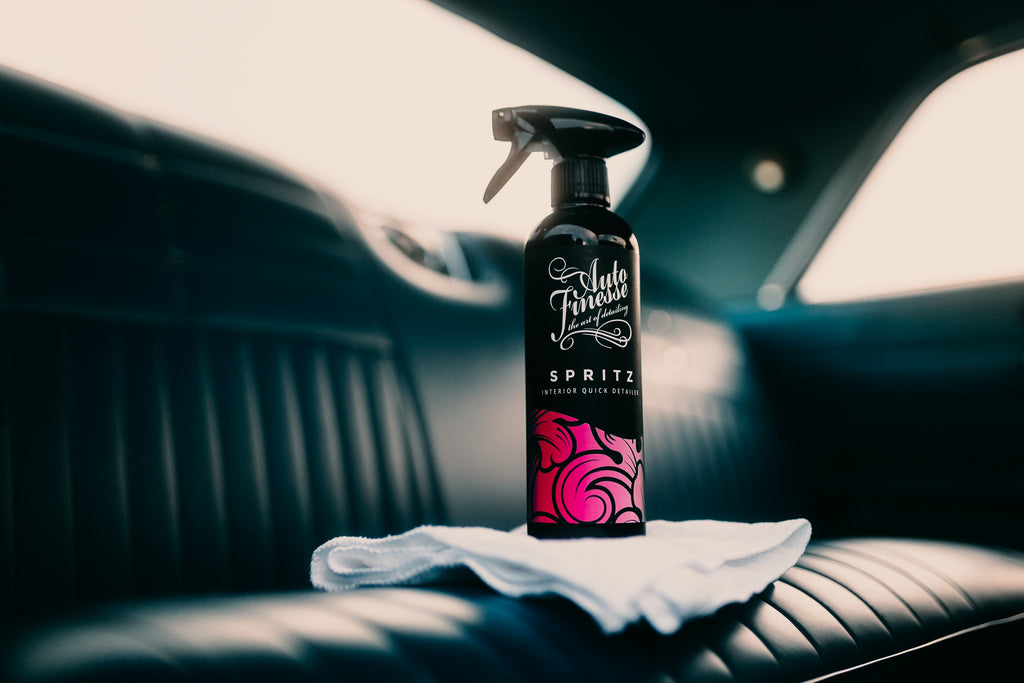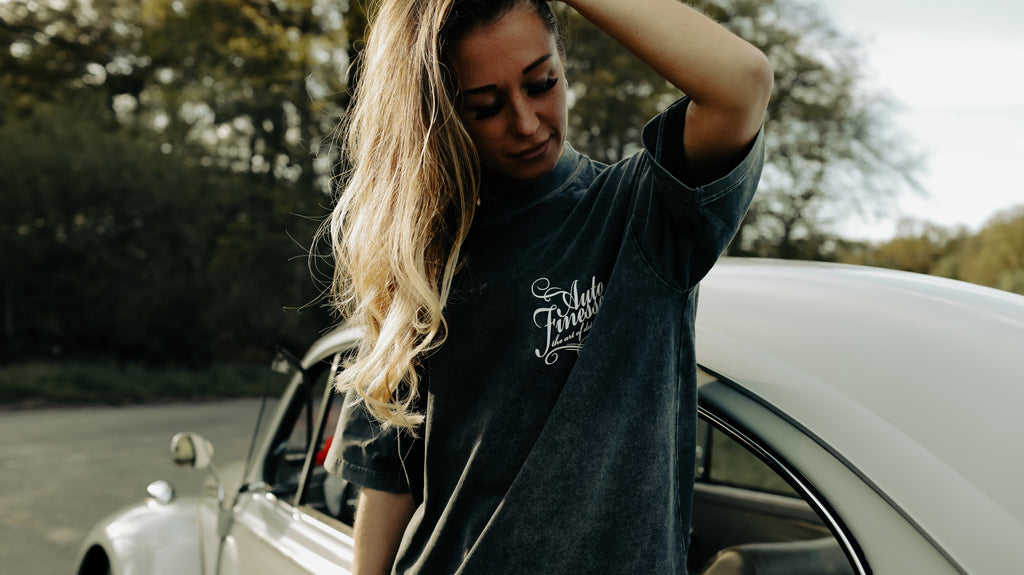Car Detailing FAQs
Frequently Asked Questions
-
Auto Finesse is a leading manufacturer of premium car detailing products, trusted by professionals and enthusiasts since 1999. Our range includes cleaners, waxes, polishes, and more.
-
All Auto Finesse products are proudly designed, developed, and manufactured in the UK.
-
Yes! Our products are easy to use, with clear instructions, making them perfect for both beginners and professionals.
-
Absolutely! Our products are safe and effective for all vehicle types, including classic cars, modern vehicles, and even motorcycles.
-
You can purchase them directly from our website, at select retailers worldwide, or through our network of authorised dealers.
-
Yes, we offer a 30% trade discount, exclusive products, training, and support through our Pro Portal for professional users.
-
Yes, we’re always looking to expand our network. Visit our website to apply for a dealer or distributor account.
-
We ship worldwide, with free UK shipping on orders over £50. Delivery times vary by location and are detailed at checkout.
We accept returns of unused products within 30 days of purchase. If your product is defective or damaged, please contact customer service for assistance.
Wheel Cleaning
-
Your detailing should start with washing wheels and tyres, then moving on to pre washing and snow foaming the exterior, next you can contact wash, decontamination wash, polishing and apply applying protection. Interior cleaning can be performed before or after the rest of your detail, or after the cleaning stages before polishing. Don’t forget the final touches at the end to enhance your detail, such as cleaning windows and mirrors and adding a tyre dressing.
-
Reactive Wheel Cleaner is the best product to regularly fully decontaminate alloy wheels. It’s a unique formulation is perfectly suited for painted, lacquered and powder-coated rims and includes a special fall out remover capable of dissolving embedded ferrous metal particles. Imperial Wheel Cleaner is another product that’s great for regular maintenance, this powerful formula is suitable for all wheel types and finishes, and cuts through surface brake dust and heavy soiling with ease.
-
Your wheels should be cool to the touch before you start and clean one wheel at a time. Pre rinse to remove loose debris and let your cleaners get to work on bonded grime. Apply your wheel cleaner and agitate into all surfaces with suitable brushes for the wheel type and design. Barrel Brushes or Wonder Wool Wheel Brushes for the inner wheel and soft Detailing Brushes for the lips lug nut recesses. Follow up with all other areas using a Plush Wheel Mitt. Before rinsing clean your tyre with Tread Tyre Cleaner and a Rubber Scrubber Tyre Brush. Then rinse away the contamination.
-
The correct wheel brush for the type of wheel will never cause unsightly marks.At Auto Finesse, our wheel brushes are super-soft and designed with scratch-less bristles or lambswool/microfibre cleaning media, making them ideal for sensitive finishes. We also have specialist brushes for cleaning tyres and inner arch liners.
-
Yes, you can use a car shampoo such as Lather Car Shampoo for light cleaning on fully protected alloy wheels because the wax or coating will have stopped the contamination from sticking. A shampoo is also useful for brushing in other spray on cleaners, acting as a lubricant and helping to safely remove the most harmful grime. Our Revolution Wheel Soap is a specialist wheel cleaner and shampoo in one, and ideal for stand-alone use on the most sensitive finishes, along with brushing in other cleaners such as Imperial Wheel Cleaner or Reactive Wheel Cleaner.
-
While it’s beneficial to apply a wheel protectant, a traditional car wax isn’t the best option. Wheels are subjected to intense heat and hot brake dust that can melt through normal wax layers. Instead use a ceramic coating or a specialist high temperature wax designed specifically for wheels such as Mint Rims Wheel Wax.
-
Car care professionals recommend using a tyre dressing only on dry tyres. This ensures they are not diluted and fully bond with the rubber surface.
-
Yes, a tyre dressing not only enhances the look, nicely finishing off your detail, but can protect your tyres from cracking and fading, along with providing a barrier to the elements. Our Satin Tyre Crème nourishes and conditions your tyres from within and also allows you to choose the level of gloss your require. One application installs a like-new satin sheen, but you can build up more layers for a wet-look, show car shine.
Pre-Wash
-
Yes, every car wash should start with a thorough pre-wash. This process uses pre-cleaners and snow foams to eliminate as much heavy dirt, grit and grime as possible to cut down on the risk of causing damage when you contact wash. A pre-wash is a largely contactless safety measure used to eliminate heavy particles that may scratch surfaces if dragged across them with a wash mitt.
-
After rinsing your car fully to remove loose grit and grime, you must start with a contactless pre-cleaner, such as a citrus based pre-wash product, to remove the largest particle soiling. This is followed by using a snow foam to break down and lift bonded contamination. Only after these two pre-wash stages should you attempt to perform a two bucket contact wash. Auto Finesse has you covered with Citrus Power Bug & Grime Remover, Dynamite Traffic Film Remover and Avalanche Snow Foam for the perfect 2-stage pre-wash. For more details, visit our car cleaning pre-wash page.
-
Yes, pre-rinsing before using any cleaning agents removes loose grime and allows your cleaning products to get to work where they’re actually needed – on the harmful, bonded grime. By pre rinsing you’re not only making your cleaning products more effective by targeting their cleaning power, but you’re ensuring they’re not being wasted on grime that can be removed easily without them.
-
No, car shampoo is designed for use with a wash mitt during your contact wash, rather than during the pre-wash stages. There are dedicated pre-wash products such as Citrus Power Bug & Grime Remover and Avalanche Snow Foam, specifically designed to tackle heavy soiling before you make contact with sensitive surfaces such as paintwork. Using these specialist products prior to the contact wash stage is the best way to get the ultimate swirl-free wash.
-
Snow foam is a type of pre-wash cleaner but it differs from a spray-on pre cleaner in that it’s specifically designed to linger on the surface for as long as possible. Because snow foam is applied with a snow foam lance - which whips it up into a thick foam – this specialist pre-cleaner stays on the surface breaking down bonded contamination as it dwells. Snow foam safely lifts and surrounds potentially harmful particles, allowing them to be rinsed away without abrading the surface. We always recommend using a pre cleaner first to remove the largest gritty particles, followed by a snow foam to help break away slightly smaller harmful particles.
-
The longer a pre-cleaner or a snow foam is left to dwell, the more bonded contamination it can break away from the surface. The key is not to let any cleaner dry on the
surface. All pre-wash products are aqueous cleaning agents that use surfactants and degreasers, along with water, to clean on a molecular level. These need to remain wet to do their job safely. So, be sure to rinse away your cleaning solution, along with the grime it encapsulates, before it’s allowed to dry. -
A pre-wash is the initial step in safe
car-cleaning. Your pre wash stage loosens the most harmful contaminants before you contact wash for swirl-free paintwork. A regular wash may refer to the contact wash stage which is employed purely to address any remaining small particle grime after the pre-wash. You should never contact wash without carrying out a thorough pre-wash first. -
Some start their pre-wash on a dry car to attempt to maximise dwell time for their cleaning products. However, for the best performance and best results, we recommend thoroughly pre-rinsing and using your pre-cleaners and snow foams only on a wet, pre-rinsed vehicle.
-
The best products for pre-washing are available with Auto Finesse. Browse our collection and find the finest snow foam, citrus pre-cleaner, traffic film remover, all-purpose cleaner and more.
Contact Wash
-
Before making any contact with the car, it is advised to rinse the vehicle down and then apply a pre wash solution such as Citrus Power Bug & Grime Remover or Dynamite Traffic Film Remover. Follow this by applying Avalanche Snow Foam. This 2-stage pre wash process removes the most harmful grit and grime to ensure its not inflicting surface damage by being dragged along with your wash mitt during your contact wash.
-
Not instead of washing, no. Although rinsing down your car can help get rid of some loose surface debris, it will never be enough for complete cleaning. Only car cleaning products can eliminate the bonded grime and the types of harmful contamination your car will be subjected to day to day.
-
Yes, always rinse your car from top to bottom before beginning your pre wash, this allows your cleaning agents to get to work where they’re most needed instead of on loose grime that could have been rinsed away first. In this way you won’t waste your car cleaning products.
-
The amount of usage, weather, time of year and individual preference all influence how often you should wash your automobile. To preserve the look and protect the coating on your car, it is generally advised to wash it once every two weeks or so, but more frequent washing may be necessary. The good news is that, using our surface-safe products and professional wash techniques, you can wash your car as often as you choose without inflicting damage.
-
Auto Finesse Lather Car Shampoo is formulated specifically for the safest contact wash, making it the perfect choice for most details. This pH-neutral shampoo contains advanced surfactants and degreasers that are gentle on paintwork while effectively removing dirt and grime without stripping protection layers.
-
Automatic car wash brushes have the potential to leave scratches and swirl marks on your vehicle’s paint, particularly if they employ harsh chemical solutions that strip protection layers. It is always advised to wash your automobile by hand to avoid abrading protection layers and inflicting paint defects such as scratches and swirl marks.
-
Only if you keep surfaces wet at all times. Cleaning products should never be allowed to dry on surfaces, they need water to work effectively. We always recommend avoiding direct sunlight or hot temperatures when cleaning any vehicle to avoid water spots and potential paint damage due to cleaning products and water impurities from drying on exterior surfaces. Wash your car when it’s cooler outside or in shaded areas to achieve the best results.
-
If your cleaning in winter lukewarm water in your bucket can prove more comfortable when washing a car. Extremely hot water can cause water and soap to evaporate too quickly, leading to water spots and streaks. In most cases though the combination of cold water and the correct detailing products will have no problem in completing all cleaning tasks.
Car Paint Decontamination
-
There’s just three steps to perform after your contact wash. The first step is to pre- apply Iron OutContaminant Remover all over to dissolve ferrous metal particles andenvironmental fallout and safely rinse them away. Next you can target any sticky residues or glue using ObliTARate Tar & Glue Remover. Finally, address all kinds of bonded contamination using our Detailer’s Clay Bar and a Glide Clay Lube. These specialist decontamination products extract even the microscopic deposits toleave behind a glass-like surface, ready for polishing. Auto Finesse has every product to take a professional and a car enthusiast through the decontamination process!
-
We always recommend a three stage decontamination processbecause it’s highly likely that your car will suffer from contamination fromall three types that require different specialist products to remove. For metal contamination that’s chieflyderived from brake dust Iron Out is the solution. Sticky residues and tar canbe melted away with a strong solvent like ObliTARate and a Clay Bar will removebonded protein and mineral deposits along with light overspray.
-
Decontamination should be carried out periodically only as and when it’s needed. experts recommend around twice a year, or beforepolishing, or before the first time you add a protection layer such as a wax orsealant. On a fully protected car you don’t need to decontaminate car paintworkevery time you perform a routine maintenance wash.
-
The decontamination or ‘decon wash’ process is part of thewet work on larger details. Performing all three steps, including fall outremoval, targeted tar and glue removal and clay barring is a process thatshould take less than half an hour.
-
A clay bar physically pulls bonded contamination out of thetop layer of your paintwork. As you run the lubricated clay across the surfaceyou’ll feel less and less resistance indicating that the contaminants are nowtrapped in the bar and not on the surface. What we aim to achieve is asuper-smooth glass-like finish.
-
Glide Clay Lube encapsulates debris when the clayingprocess is underway and causes the detailing clay bar to easily slide over thepaint or clearcoat. In other words, it creates a slippery layer that’s idealfor the clay bar to glide over the surface to cut down on the risk ofscratching and marring.
-
An iron fallout remover like Iron Out is specificallydesigned to chemically dissolve sharp metal shrapnel that’s embedded inpaintwork. Chemical removal that promotes a reaction to dissolve the metal intoa solute is the only way to safely remove this type of contamination. You cansee this reaction take place as Iron Out Turns blood red when metal is present,then the solute of Iron Out and metal can be safely rinsed away.
-
Iron Out is safe to use on exterior surfaces such aspaintwork, wheels and glass. As long as the solution isn’t left to dry, it willnot harm these parts of your car in any way.
-
ObliTARate Tar & Glue Remover is a powerful solventbased product that cuts through sticky residues and roar tar with ease, butit’s safe to use on all painted surfaces.
Car Polish
-
Waxing and polishing are two different processes that serve two different purposes. Polishing is used for removing imperfections like scratches, swirl marks and oxidation from the paint surface, restoring its smoothness and shine. Waxing offers a protective layer over the paint to shield it from environmental damage and enhance its gloss. Both of these processes are beneficial for maintaining the visual appearance and longevity of your car’s paintwork. Polish to correct, wax to protect.
-
Car polish is used to restore and enhance paintwork and is particularly beneficial when starts showing signs of dullness or imperfections. This includes light scratches, swirl marks, a lacklustre appearance or oxidation. We also recommend polishing your car before applying a sealant, wax or coating to ensure maximum durability and adhesion of the protective layer. And to make sure you’re not locking in defects.
-
You don’t need to polish your car after every wash as this will remove the protection layers. Periodic polishing followed by adding protections layer can help preserve and enhance the appearance of your car. Your driving style, the condition of the paint and the exposure to outside elements can all affect how often you should polish your car.
-
Some common car polishing mistakes to avoid are:
- Not cleaning your car properly first
- Using poor-quality detailing products
- Applying excessive pressure
- Polishing an area that is too large in one go
- Using dirty or contaminated accessories
- Polishing in direct sunlight
-
The kind of paintwork and the necessary amount of correction determine which polishing pad is appropriate. Foam machine polishing pads tend to offer the best combination of cutting force and finishing abilities, these are advised for most paint correction processes. Our foam Machine Polishing Pads are graded from coarse (heavy cutting) to fine (refining) to help you choose the right product every time. Microfibre pads are reserved for the most severe defects that require heavier restorations.
-
The best for polishing a car safely is a dual-action polisher, otherwise known as a random orbital polisher. These devices successfully remove defects and enhance shine while minimising the chance of paintwork damage thanks to their random pattern oscillation. Both novice and seasoned detailers will find our MPX and DPX Dual Action Machine
Polishers to be extremely effective and user-friendly. -
Yes, buying a car polisher is worth it if you are serious about keeping your car looking its best. In comparison to hand polishing, using a machine polisher for larger details helps to break down the kinds of polishes and compounds needed for removing the worst defects. Furthermore, you will have more control ensuring consistent results.
-
Abrasive products like car polish compounds and paintwork cleansers are used to remove surface flaws such as oxidation, swirl marks, and scratches. Instead of removing defects directly they level down the whole surface around it until the bottom of the defect is reached and it disappears. In other words they take away a tiny portion of the top layer to reveal a fresh layer underneath.
-
Yes, polishing products are made specifically for removing surface flaws like scratches and swirl marks from in the top layer of your paintwork or clear coat. The kind of paint and the extent of the scratches however, will always determine the specific grade of compound you need to cut through the defect.
-
Yes, you can use metal polish on a car, but only on the bare metal surfaces. Our Mercury Metal Polish is designed to effectively remove stains, oxidation and tarnishing from metal surfaces like aluminium, chrome, and stainless steel. Metal polishes use abrasive particles and cleaning chemicals that can be damaging to automotive paint. So, ensure the metal polish you use is only applied to specific metal parts like exhaust tips, brightwork or chrome trim.
Car Wax
-
Waxing your car is always a good decision. Every vehicle has paintwork or clear coat that deserves to be preserved. Without adequate protection salt, bird droppings and corrosive elements will ruin your paintwork over time. Applying a car wax keeps the exterior in prime condition and can even help retain the resale value. For the best in performance and longevity check out our Signature Car Waxes. These have been designed by our in-house detailers to create a water-repellent surface to provide long-lasting protection from the elements.
-
We recommend decontamination before waxing for the first time. This eliminates the contaminants from the exterior and stops them being locked in by the wax. It also prepares the surface to stop waxes and sealants failing to bond with your auto body properly.
-
No, premium waxes cannot damage paintwork, they contain no abrasives. When applying a thin layer is always recommended and waiting at least 4-hours for the first coat to cure before adding a second.
-
Washing a car with the wrong car shampoo can strip wax from the exterior. At Auto Finesse, we present professionals, car care enthusiasts and DIY detailers with powerful yet gentle car cleaners and shampoos that are wax, sealant and coating-safe. Enjoy a swirl-free finish with them without stripping your protection layers.
-
You can top up recently applied wax. Periodically adding another layer after your car wash prolongs the life and performance of the protection layers that are already there.
-
A car wax offers optimal protection, shielding the exterior from contaminants like UV rays, dust, and dirt. It’s also vital to ensure a lasting shine. You don’t need to wash your car immediately after waxing. When you perform maintenance washes, always pre wash, contact wash using two Detailing Buckets and one of our soft microfibre or lambswool wash mitts and a pH-neutral wax-safe cleaning agent such as Lather Car Shampoo. To prolong the life and performance of your wax, and to cut down on the risk of damage to the surface don’t use automatic washes, their abrasive brushes and harsh chemicals can strip off the wax.
-
Waxing not only safeguards a car’s exterior but also provides a deep shine to it. The wax layer fills in the microscopic imperfections to smooth the surface for light to reflect uniformly, giving the impression of depth and increased gloss. The presence of natural carnauba wax also enhances the finish with a warm glow.
